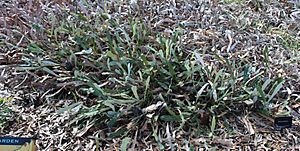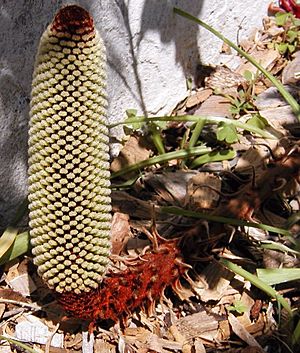Banksia petiolaris facts for kids
Quick facts for kids Banksia petiolaris |
|
|---|---|
 |
|
| Flower spike, cultivated in Sydney | |
| Scientific classification | |
| Kingdom: | |
| (unranked): | |
| (unranked): | |
| Order: | |
| Family: | |
| Genus: | |
| Subgenus: | |
| Section: | |
| Series: |
Banksia ser. Prostratae
|
| Species: |
B. petiolaris
|
| Binomial name | |
| Banksia petiolaris |
|
 |
|
| Range of Banksia petiolaris in green | |
Banksia petiolaris is a special kind of flowering plant that grows in Western Australia. It's part of the Proteaceae family, which includes many unique Australian plants. This plant is quite rare and is found in sandy areas along the south coast, from Munglinup to Israelite Bay.
It was first discovered and described in 1864 by a botanist named Ferdinand von Mueller. Banksia petiolaris is a prostrate shrub, meaning it grows flat along the ground. It has thick, leathery leaves that stand upright. What's really cool is that its leaves can live for up to 13 years! This is the longest lifespan recorded for any flowering plant leaf.
In spring, it grows bright yellow, cylinder-shaped flower spikes. These spikes can be up to 16 centimeters (about 6 inches) tall. As the flowers get older, they turn grey and form up to 20 woody seed pods, called follicles. These pods hold the seeds for the next generation of plants.
Insects like bees, wasps, and even ants help pollinate its flowers. After a bushfire, Banksia petiolaris can't regrow from its roots. Instead, it relies on its seeds to start new plants. This plant is also quite easy to grow in gardens, especially in sunny spots with sandy soil. It's great for rockeries or as a groundcover.
Contents
What Does Banksia petiolaris Look Like?
Banksia petiolaris is a prostrate shrub, which means it spreads out low to the ground. It can grow up to 2 meters (about 6.5 feet) wide. Its thick stems lie flat on the ground and are covered in fine hairs. When new parts of the plant grow, they have soft, orange-brown hairs.
Leaves and Flowers
The plant has large, leathery leaves that grow straight up from stalks called petioles. These stalks can be up to 15 centimeters (about 6 inches) tall. The top surface of the leaves usually faces north and tilts slightly. The leaves themselves can be very long, up to 60 centimeters (about 2 feet) in length and 4 centimeters (about 1.5 inches) wide. They are a dull green color on top and white underneath, with jagged edges. Old, dead leaves stay on the plant.
The flowers appear in late spring. They are bright yellow and shaped like cylinders, growing between 9 and 16 centimeters (about 3.5 to 6 inches) tall. As the flower spikes age, they turn grey, and the old flowers remain on the plant.
Seeds and Seed Pods
Each flower spike can develop up to 20 woody seed pods, called follicles. These pods are oval-shaped and covered with fine grey fur. They are about 2.8 to 3.8 centimeters (1 to 1.5 inches) long.
Inside the pods, the seeds are fairly flat and about 2.5 to 2.8 centimeters (1 inch) long. Each seed has a triangular body and a papery wing that helps it spread. When a new plant sprouts, its first leaves, called cotyledons, are wedge-shaped and dull green. The next leaves that grow are oval with small teeth on the sides.
Banksia petiolaris looks quite similar across its different locations. You can tell it apart from other low-growing banksias by its yellow flower spikes and the white underside of its leaves.
Naming and Classification
Banksia petiolaris was first officially described by the Victorian state botanist Ferdinand von Mueller in 1864. Its scientific name, petiolaris, comes from Latin and means "with petioles," which refers to the plant's long leaf stalks. The first sample of this plant was likely collected in 1861 between Cape Le Grand and Cape Arid.
Over the years, botanists have studied and classified Banksia petiolaris to understand its place in the plant world. It belongs to the Banksia genus, and specifically to a group of banksias that grow flat on the ground. Scientists have used different methods, including looking at the plant's physical features and its DNA, to figure out how it's related to other plants.
One important classification places Banksia petiolaris in:
- The genus Banksia
- The subgenus Banksia subg. Banksia
- The section Banksia sect. Banksia
- The series Banksia ser. Prostratae
This means it's grouped with other banksias that have similar flower spikes and grow in a prostrate (flat) way. Some studies suggest its closest relative might be Banksia brevidentata.
Where Banksia petiolaris Lives
Banksia petiolaris is endemic to Western Australia, meaning it's only found there. It grows near the state's south coast, from Munglinup east to Israelite Bay. It's mainly found in two separate areas: one around Cape Arid National Park and another east of Scaddan.
You'll usually find it in white sandy soils in areas called kwongan or mallee heathland. Sometimes, it grows alongside the taller Banksia speciosa. It's often quite common in these areas, with many groups having over 100 plants.
How Banksia petiolaris Survives
Like many plants in Australia's Southwest, Banksia petiolaris is used to frequent bushfires. Most Banksia species react to fire in one of two ways:
- Reseeders: These plants are killed by fire, but the fire helps release their seeds, allowing new plants to grow.
- Resprouters: These plants survive fires by regrowing from special underground stems or protected buds.
Banksia petiolaris is a reeseeder. This means it grows quickly, but a bushfire will kill the plant. However, the fire also helps its seeds sprout, starting a new generation. Other low-growing banksias are usually resprouters, which grow more slowly.
Pollination and Threats
Like other banksias, Banksia petiolaris is visited by many different pollinators. Bees, wasps, and ants have all been seen pollinating its flowers.
Scientists have looked at how climate change might affect this plant. They predict that its natural range could shrink by 30% to 80% by 2080. Many of its western populations are found along roadsides, which makes them vulnerable if roads are changed or widened. Luckily, this plant is quite resistant to a common plant disease called Phytophthora cinnamomi, which affects many other Western Australian banksias.
Long-Lived Leaves
One of the most amazing things about Banksia petiolaris is its incredibly long-lived leaves. A study in 1992 found that a single leaf could live for up to 13 years! Even old leaves, 10 years old, were still very good at photosynthesizing (making food from sunlight). Scientists think that having long-lived leaves is helpful for plants growing in soils that don't have many nutrients. This is because the plant doesn't lose valuable nutrients by constantly shedding and regrowing leaves.
Growing Banksia petiolaris
Banksia petiolaris is a popular plant in Australian gardens. It makes an attractive low-growing groundcover or a great plant for a rockery. It can also be planted on slopes to help stop soil from washing away.
Even though it's somewhat resistant to dieback disease, it needs soil that drains well, ideally sandy soil. Like other banksias, it grows best in full sun. It can even handle alkaline soils, with one plant growing well in soil with a pH of 9.5. Its seeds don't need any special treatment to sprout and usually take about 18 to 49 days to germinate.




